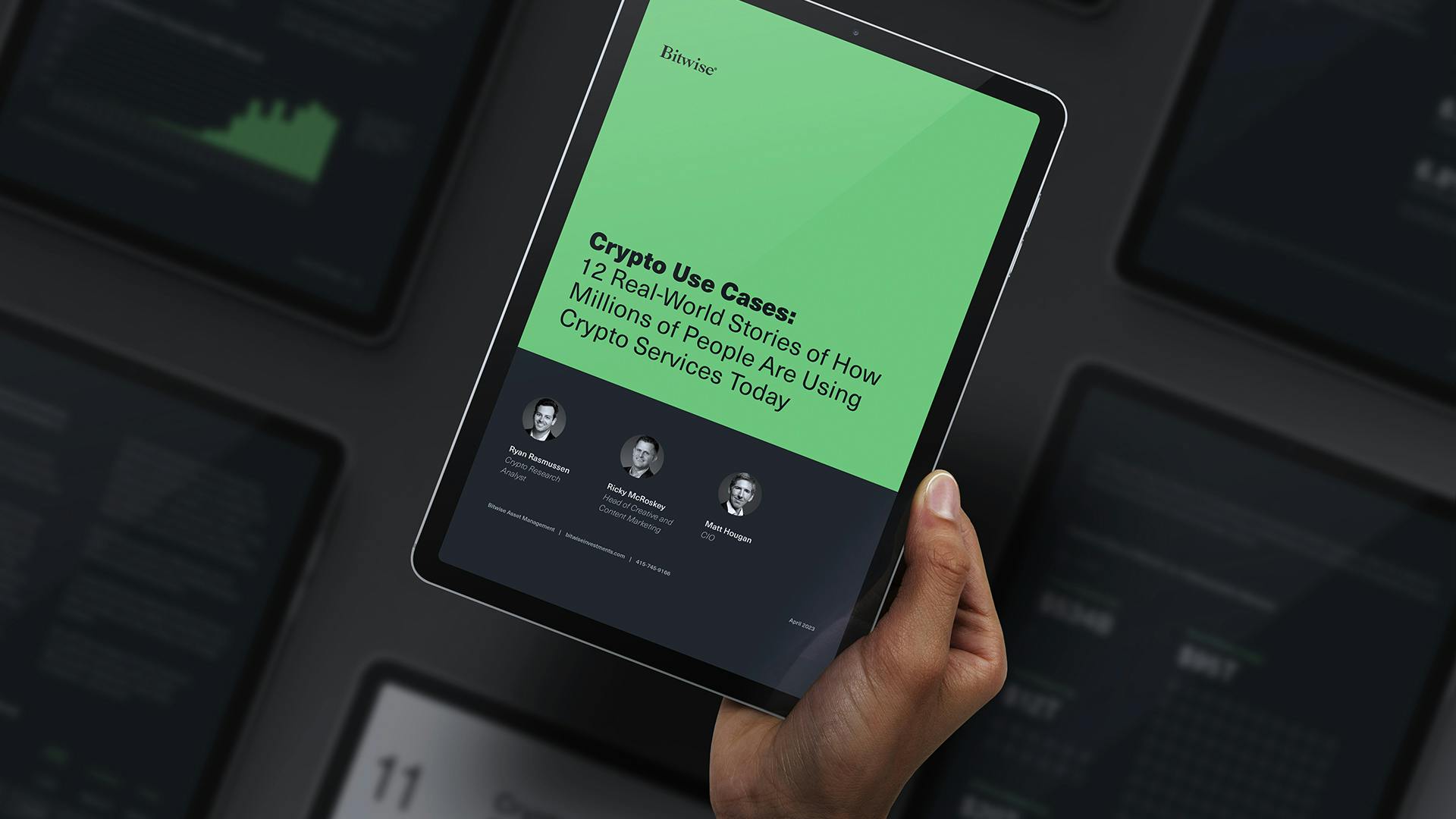A Complete Introduction to Stablecoins
San Francisco • Sep 25, 2018
Stablecoins have exploded onto the scene, but how do they work? Bitwise examines three flavors and explores the opportunity.
The price of most cryptocurrencies is determined by the marketplace, where buyers and sellers exchange coins and a price is discovered by supply and demand. In contrast, stablecoins seek to achieve a fixed price, which happens through a variety of means.
The goal of this memo is to explore the current state of the stablecoin market, including how it works, why it is important, and what investment opportunities may or may not be worth exploring.
Note that parts of this report were adapted and/or copied from a Medium post by Bitwise researcher Phil Glazer, while others were developed specifically for this memo.
Section 1: Why Are Stablecoins Important?
The goal of creating a stablecoin—a widely used fixed-price cryptocurrency—is to enable a greater number of use cases than current cryptocurrencies allow.
At the moment, cryptocurrencies are primarily held by investors and speculators seeking to profit from price appreciation. Few people hold and use cryptocurrencies like they would U.S. dollars (receiving a salary, paying for groceries, etc.) because prices fluctuate significantly day-to-day, creating significant basis risk against goods and services.
A viable stablecoin could enable:
Increased global access to a stable currency: The relative stability of the U.S. dollar is taken for granted. While inflation slowly erodes the value of the dollar, this gradual erosion is very slight compared to the hyperinflation that takes place in countries like Argentina, Egypt, and Nigeria, where annual inflation rates can exceed 15% a year. People in these countries seek to hold physical U.S. dollars to preserve their wealth. Often, however, capital controls prevent citizens from legally transacting in foreign currencies, or from exporting currency holdings abroad, limiting the utility of this escape valve.A digital, decentralized currency that is widely accessible and price-stable would offer a much-needed alternative for people living in countries with unstable monetary systems and restrictive capital controls.
A currency for a crypto-based lending and derivatives market: One promising use case for cryptocurrencies/blockchains is to serve as the infrastructure for a modern financial ecosystem with fewer intermediaries, lower fees, and fewer inaccuracies. For capital markets to form around a cryptocurrency, however, it is a requirement that price levels be fairly stable. Issuing ether-based loans on the Ethereum blockchain is currently prohibitive at scale, for instance, because both the lender and borrower take on significant currency risk by basing the loan in ether.Indeed, having a stable currency value is one of the primary goals of the Federal Reserve, and for good reason: Being able to rely on the price and value of a given currency is key for building expectations and engaging in economic activity. As explained by the St. Louis Fed, “Price stability means that inflation is sufficiently low and stable so as not to influence the economic decisions of households and firms. When inflation is low and reasonably stable, people do not waste resources attempting to protect themselves from inflation. They save and invest with confidence that the value of money will be stable over time.”
Section 2: How Do Stablecoins Work?
There are three approaches to developing a price-stable cryptocurrency: fiat-collateralized, crypto-collateralized, and seignorage shares (essentially an independent, noncollateralized currency maintained by an “algorithmic central bank”).
Approach #1: Fiat-Collateralized Stablecoins
Overview: This implementation is the least imaginative, but most tangible: Each unit of the stablecoin is backed by a corresponding unit of fiat currency, like a U.S. dollar.
Implementation: The mechanics for implementation are fairly straightforward. A third party takes deposits in U.S. dollars (or another desirable fiat currency) and issues a unit of stablecoin for every dollar deposited. To cash out of a unit of stablecoin, the third party wires a U.S. dollar to the holder and burns a unit of the stablecoin.
Pros:
Easy to conceptualize
Value will match USD with certainty if properly implemented (digitized dollars without capital controls)
Cons:
Must trust third party to hold fiat collateral
Needs additional third party for audit to ensure appropriate collateral is being held and units of stablecoin match deposits
Is expensive and slow to audit
Key Consideration: Transparency from the third-party responsible for custody and issuance, and trust of the auditors monitoring the project, are both essential for fiat-collateralized stablecoins to succeed.
Approach #2: Crypto-Collateralized Stablecoins
Overview: This approach relies on cryptocurrency collateral instead of fiat collateral. Instead of backing units of a stablecoin 1:1 with fiat currency, crypto-collateralized stablecoins hold a ratio greater than 1:1 of a cryptocurrency (or basket of cryptocurrencies) and issue units of a stablecoin supported by the cryptocurrency reserve.
Implementation: This method is conducted on-chain using a cryptocurrency, like ethereum, as collateral. As such, it does not require users to trust a third party in the same way that the fiat-collateralized method does. The concern for crypto-collateralized offerings, however, is that the underlying collateral is highly volatile. Therefore, to be protected against significant price drops, a significant amount of overcollateralization must be held—as much as 2:1 or even greater.
Pros:
Does not rely on third-party custody like fiat-collateralized stablecoins
Is conducted on-chain, which enables a faster increase/decrease of stable coin units and liquidity than fiat-collateralized stablecoins
Is transparent to external parties without the need for auditors
Cons:
Is not capital efficient
Has a complex selection process if a basket of cryptocurrencies is used, and questionable price stability/security if just one cryptocurrency is used for collateral
Key Consideration: The high required levels of collateralization present a potentially significant barrier to widespread adoption of this approach.
Approach #3: Seignorage Shares Stablecoins
Overview: This approach does not rely on being collateralized by either fiat or cryptocurrency holdings. To maintain the price level, a “central bank” is created that algorithmically maintains the supply of currency, increasing it when price goes up and decreasing it when price goes down. It is the most complex—and potentially the riskiest—solution, but also potentially the most impactful for the ecosystem.
Implementation: Seignorage works by following a rules-based system designed to keep the price of a stablecoin anchored at a particular value (like $1). In the case that the price trades above $1 per unit, the smart contract central bank will issue additional units to increase supply until the price reaches $1, collecting profits (known as seignorage) in the process. If the price drops below $1, the central bank will use seignorage profits to buy units, thereby decreasing supply and increasing price.If the price is still below $1/unit after the central bank has spent all its seignorage, the central bank will issue “seignorage shares” … essentially IOUs that promise future seignorage to buyers to raise funds.One project that implements this method is Basis, and additional details can be found in the Basis white paper.
Pros
Does not require collateral
Theoretically risk-independent of other currencies (though if there is a general decline in cryptocurrencies as an asset class, there would likely be a decline in demand for seignorage shares)
Cons:
Not as intuitive or easily explained as other structures
Input of future expectations for seignorage shares means that it cannot be known how resilient a coin is to downward pressure
Requires always-increasing future demand
Key Consideration: This system is predicated on the future growth of demand for stablecoins. If the central bank reaches a point where the currency is below $1/unit after it has depleted its reserves, and it is unable to sell seignorage shares to raise funds, traders will lose faith in the future prospects of the stablecoin and its price may enter a death spiral. Seignorage-based stablecoins can sustain some downward pressure, but it is difficult to evaluate just how much pressure they can sustain because resiliency is tied to the expectations of seignorage share buyers.
Section 3: The Investment Case
Most stablecoins are not particularly exciting investments; they are, by definition, intended to be stable and to not change in value. There are, however, a few emergent ways that people are seeking to profit on stablecoins. They include:
Arbitrage on Pegged Coins: Stablecoins—even coins functioning well—may temporarily deviate from the targeted value. For instance, Tether—which is pegged to the U.S. dollar—regularly trades in a range between $0.98 – $1.02, and an arbitrage profit may be available when it trades away from its $1.00 target price.
Bonds Purchases: For seignorage shares, when supply contracts, units can be exchanged for bonds that are repaid in the future when supply expands. The bonds are issued at a discount (for example, 80 cents on the dollar), and if supply expands in the future, these bonds are repaid. There is a risk that the supply does not expand and units exchanged for bonds expire worthless (in Basis, there is a five-year maximum time period for bond repayment).
Capitalization Shares: The Basis white paper (and potentially others) proposes a class of shares that will receive a claim on some portion of future issuance of Basis. For instance, if $100 million of Basis exists today, and another $100 million is issued to meet rising demand, these shares will receive a payment reflecting a portion of that $100 million in issuance. These Capitalization Shares can be seen as a way for Basis to raise capital reserves for its central bank, and the payments are compensation for tying up capital and putting it at risk.
Related Cryptoassets: Maker is a cryptocurrency-backed stablecoin. The stablecoin is called Maker Dai (or Dai for short) and is collateralized by a large position in ether. Dai is not an interesting investment on its own, as it aims for stability. The Maker platform, however, has a second coin—called Maker (MKR)—which is the “governance token” for the Maker Dai project. The MKR coin has voting rights on the project and, more importantly, people creating new DAI must pay a fee in MKR. This creates demand for MKR. As a bonus, when a fee is paid, the process destroys MKR, decreasing supply and potentially raising prices.
To date, none of these investment opportunities are captured in either the Bitwise HOLD 10 Private Index Fund or Bitwise’s large cap, mid cap, small cap, or total market indexes. Nonpegged cryptoassets like MKR would qualify if they met all of our investability criteria; currently, MKR does not have sufficient trading volume to support institutional investment. In the future, if a coin like MKR gains significant traction, we would not be surprised to see it enter one of our indexes.
Bitwise Asset Management is a global crypto asset manager with more than $15 billion in client assets and a suite of over 30 investment products spanning ETFs, separately managed accounts, private funds, hedge fund strategies, and staking. The firm has an eight-year track record and today serves more than 4,000 private wealth teams, RIAs, family offices and institutional investors as well as 15 banks and broker-dealers. The Bitwise team of over 125 technology and investment professionals is backed by leading institutional investors and has offices in San Francisco, New York, and London.



